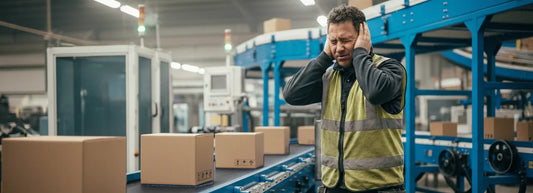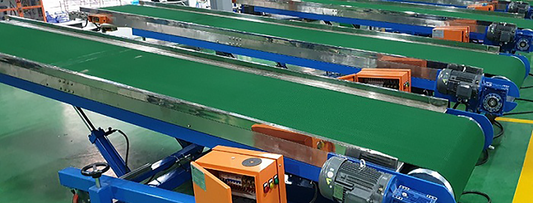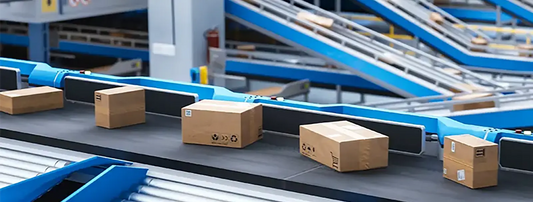Conveyor Belt Material: Choosing the Right Material for Optimal Performance
Conveyor belts are the workhorses of various industries, responsible for the efficient transportation of goods and materials from one place to another. The immense value they provide in all industries hinges significantly on their construction materials. Conveyor belt materials determine the belt's strength, durability, and suitability for different applications. Choosing the right conveyor belt material is crucial for ensuring optimal performance and longevity.
Cover Materials for Conveyor Belts: The First Line of Defense
The cover material is the outermost layer that directly interacts with the conveyed material. It acts as the first line of defense against wear, abrasion, chemicals, temperature, and other damaging factors. The choice of cover material is crucial because it must align with the operational demands of the application.
The most common materials that conveyor belts are made out of include:
- PVC (polyvinyl chloride)
- PU (polyurethane)
- PE (polyethylene)
- TPEE (Hytrel®)
- Silicone
- Fabric
- Felt

PVC (polyvinyl chloride): Low cost, durable, and flexible. Suitable for less demanding applications, such as agriculture processing or light manufacturing.
PU (polyurethane): Strong and durable with exceptional resistance to grease, oils, chemicals, cuts, and tears. Lightweight and energy-saving. Suitable for food processing and other demanding applications.
PE (polyethylene): Excellent chemical resistance and release properties. Especially developed for the tobacco processing industry.
TPEE (Hytrel®): More abrasion-resistant than PE. Meets FDA and EU specifications for dry food.
Silicone:High-temperature resistance, high-level of release/ non-stick properties and superior resistance to chemicals, greases, and oils. Suitable for food processing and sanitary applications.
Fabric and Felt: Fabric and Felt belts are often used in logistics, automotive and food processing industries for delicate products that require a soft touch – and where noise reduction is important.

Fabric Material: The Backbone of the Belt
The fabric material forms the carcass of the conveyor belt, providing the necessary tensile strength to carry loads while maintaining flexibility. The selected fabric can dramatically influence the belt's performance characteristics, such as load capacity, impact resistance, and the ability to navigate around pulleys.
Common Fabric Materials:
- Cotton/Natural Fibers: Once common, but less frequently used today due to stretching and loss of strength under heavy loads or in moist environments.
- Nylon: High strength and excellent resistance to impact and abrasion. Suitable for heavy-duty applications.
- Polyester: Low stretch and high strength, especially in the weft direction. Dimensional stability and resistance to moisture make it a widely used fabric in KCB's conveyor belts.
- Aramid (Kevlar): Extreme strength with light weight. Resistant to heat and flame. Ideal for textile printing and other heavy-duty applications.
- Solid woven: High-quality spun polyester warp yarns interwoven and bound together with weft yarns. When fused and impregnated, this interwoven carcass provides excellent tear and impact resistance along with dimensional stability, delivering high performance solutions for general conveying.
- Glass-Fiber: High heat resistance. Used with silicone or PTFE covers for continuous operation in high-temperature environments.

Choosing the Right Conveyor Belt Material
When selecting a conveyor belt material, consider the following factors:
- Type of material being transported: The material's weight, size, and abrasiveness will influence the cover material choice.
- Operating temperature: The belt must be able to withstand the operating temperature without degradation.
- Chemical environment: The belt must be resistant to any chemicals it may come into contact with.
- Desired belt life: The material's durability will determine the belt's lifespan.
- Application requirements: Consider specific requirements such as noise reduction, food contact, or flame resistance.
Conclusion:
As industries evolve, so do conveyor belt materials. Kunming Conveyor Belt continue to innovate, combining various cover and fabric materials to meet the ever-changing demands of different applications. In conclusion, choosing the right conveyor belt material is essential for ensuring optimal performance and longevity. By understanding the properties and capabilities of both the cover and fabric materials, you can select the best solution for your specific application. By matching the right materials to your specific needs, you can ensure that your conveyor belt operates smoothly, efficiently, and with the longevity needed to support your operational goals. Remember, the material components of a conveyor belt are an investment in productivity, and with so many options available, there's a conveyor belt material engineered to meet virtually any industrial challenge.







